On View
‘It’s a Strange Communion’: Artist Michael Rakowitz on Why He Set Up an Iraqi Food Truck Outside the MCA Chicago
The long-standing project began in his mother's kitchen.
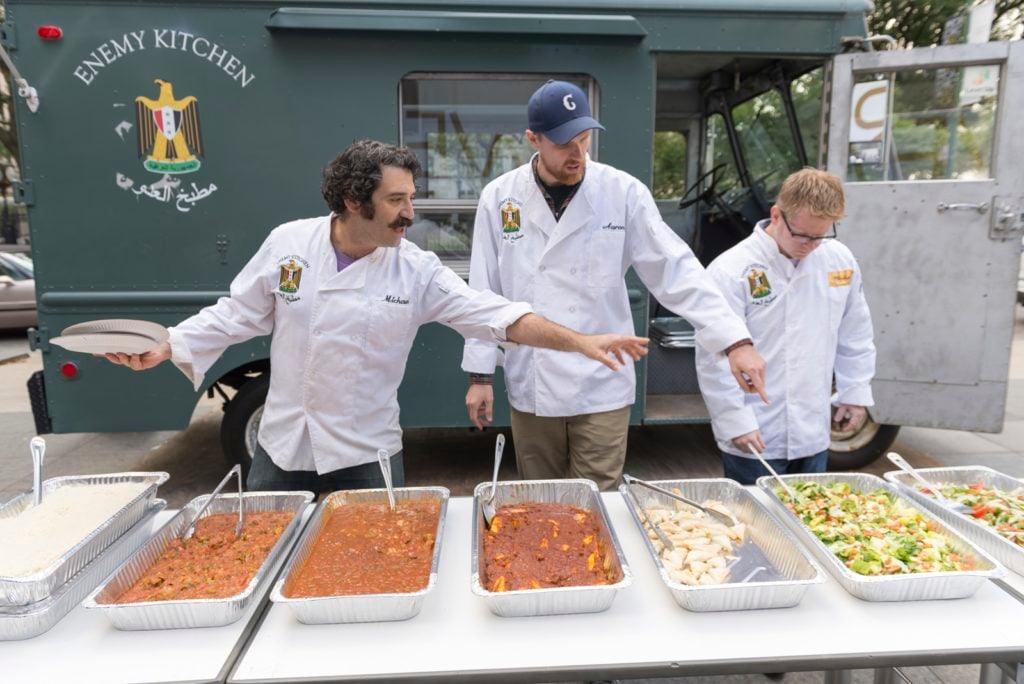
The long-standing project began in his mother's kitchen.

Brian Boucher

Visitors to the Museum of Contemporary Art Chicago this past fall may have stumbled upon a food truck where American veterans of the Iraq War served traditional Iraqi food. Enemy Kitchen (ongoing since 2003) is part of “Michael Rakowitz: Backstroke of the West,” which surveys 20 years of the Chicago artist’s work.
“How could this generous hospitality be the fruit of such hostility?” asks MCA curator Omar Kholeif in the show’s catalog, situating the work in the context of the American military action in Iraq.
Descended from Iraqi Jews who fled the country during strife in the 1940s, Rakowitz draws inspiration from the intertwined histories of his ancestors’ homeland and the country to which they migrated. The show is full of surprises, some tragic, some hilarious. For example, Saddam Hussein’s family members were such Star Wars fans that the dictator erected a monument that echoes a poster for The Empire Strikes Back. Saddam also wrote his own fantasy fiction.
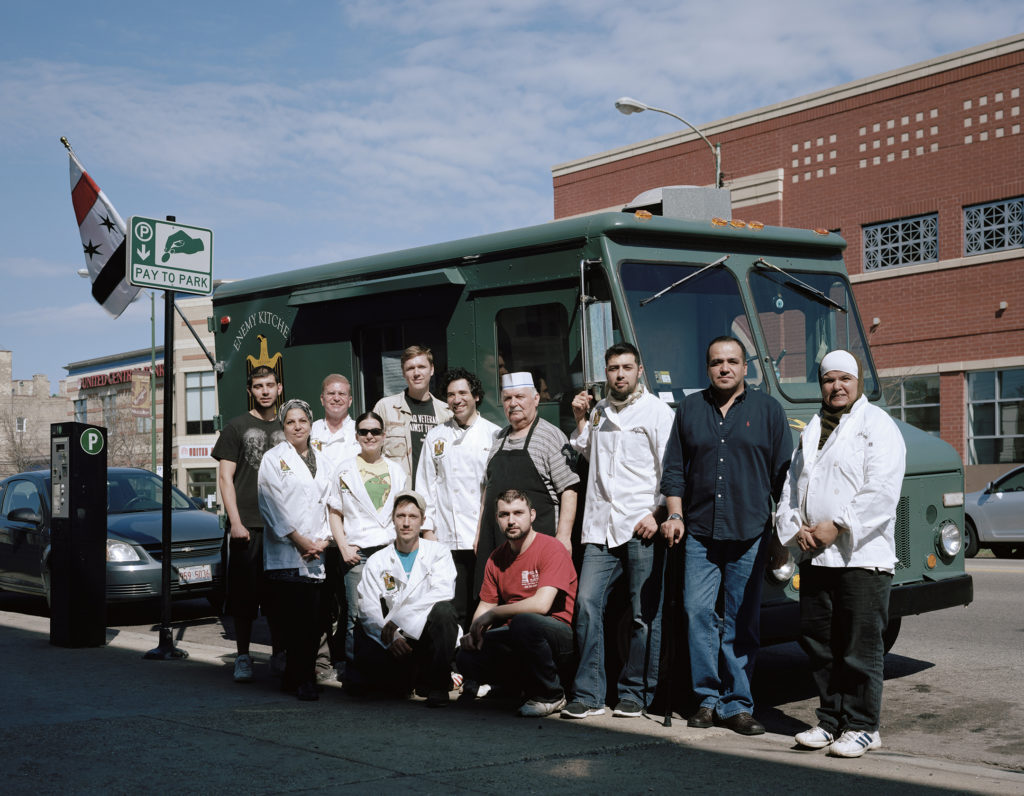
Michael Rakowitz’s Enemy Kitchen (2012–ongoing). Photo by Greg Broseus, courtesy of the artist and Rhona Hoffman Gallery, Chicago; Jane Lombard Gallery, New York; Galerie Barbara Wien, Berlin.
The exhibition takes its title from a Chinese bootleg’s mis-translation of The Revenge of the Sith. It includes major works such as The Invisible Enemy Should Not Exist (ongoing since 2007), which consists of lovingly made replicas of treasures looted from the National Museum of Iraq, which Rakowitz crafted from Middle Eastern newspapers and food packaging; and What Dust Will Rise? (2012), which appeared in Documenta 13 and compares the destruction that World War II wrought in Germany with the Taliban’s demolition of the Bamiyan Buddhas in 2001.
A professor of art theory and practice at Northwestern University, Rakowitz has appeared in exhibitions at the Museum of Modern Art and Tate Modern, and was chosen as the artist for the 2018 edition of London’s Fourth Plinth public art project. He shows his work at Chicago’s Rhona Hoffman Gallery and at Jane Lombard Gallery in New York.
For this edition of “Origin Story,” which explores the backstories of individual works of art, we spoke to Rakowitz about the evolution of Enemy Kitchen, which began in his own family home before traveling to a public housing project and then to the Chicago museum.
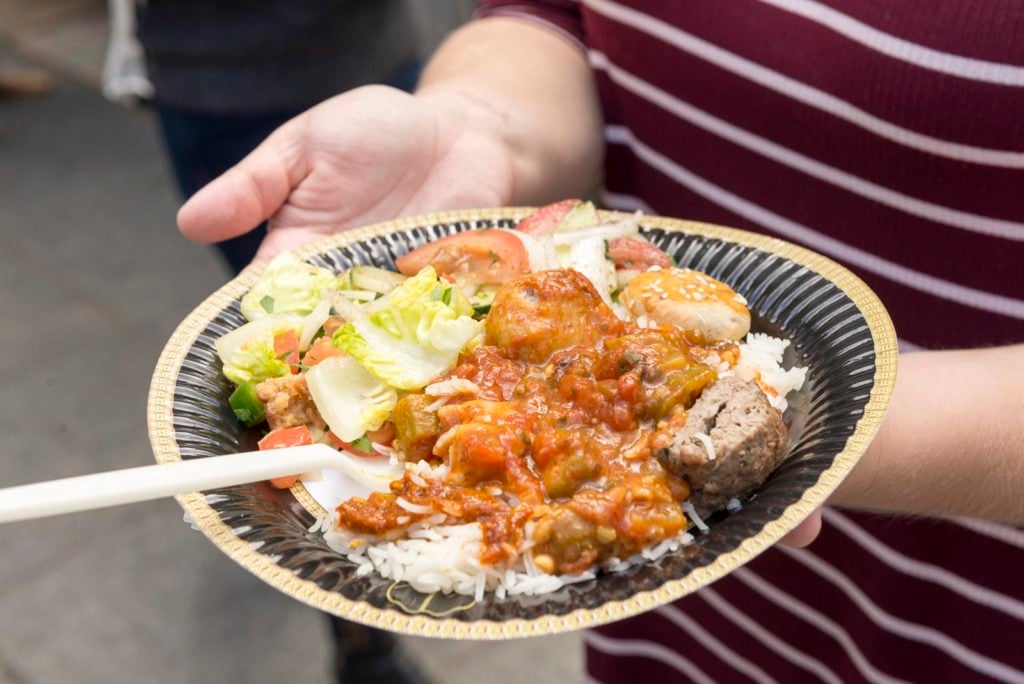
Activation of Michael Rakowitz’s “Enemy Kitchen (2012–ongoing), on the MCA’s plaza. Photo by Nathan Keay, © MCA Chicago.
So, speaking of origins, this piece traces back to your mother, right?
Yes. I grew up on Long Island and often heard my mother and grandmother speaking Arabic, often in the kitchen. It wasn’t until the first Gulf War started, in 1990, when the place my family fled from was being destroyed by the place they fled to, that I became politicized. And out of nowhere, my mother said, “You know, there are no Iraqi restaurants in New York.”
Then, shortly after 9/11, I saw a huge crowd waiting to get into Khyber Pass, an Afghan restaurant in New York. I wanted to weep, it was such a beautiful way for people to say that their grief was not a call to war, and it was a strange communion, taking in the food of the enemy. I thought about what my mother said. As the US was heading toward war with Afghanistan and Iraq, I started to think about her cooking as a dying language, and I started teaching her recipes in New York, where I was living then.
How did audiences receive these lessons, especially those within a stone’s throw of the World Trade Center?
I taught these workshops for about nine years, so eventually I was teaching kids who had spent a chunk of their lives in a war culture. At one point I was teaching at the Hudson Guild Children’s Center, in a public housing project in Chelsea. Some kids had relatives in Iraq but teachers were forbidden from discussing that, which I found incredibly backward.
One kid, when we were making kubba, said, “Why do we have to make this nasty food when the Iraqis knocked down the Twin Towers?” And another kid said, “It wasn’t the Iraqis who knocked it down; it was bin Laden.” And another said “No, it was our own government.” So the project opened up a space for conversation.
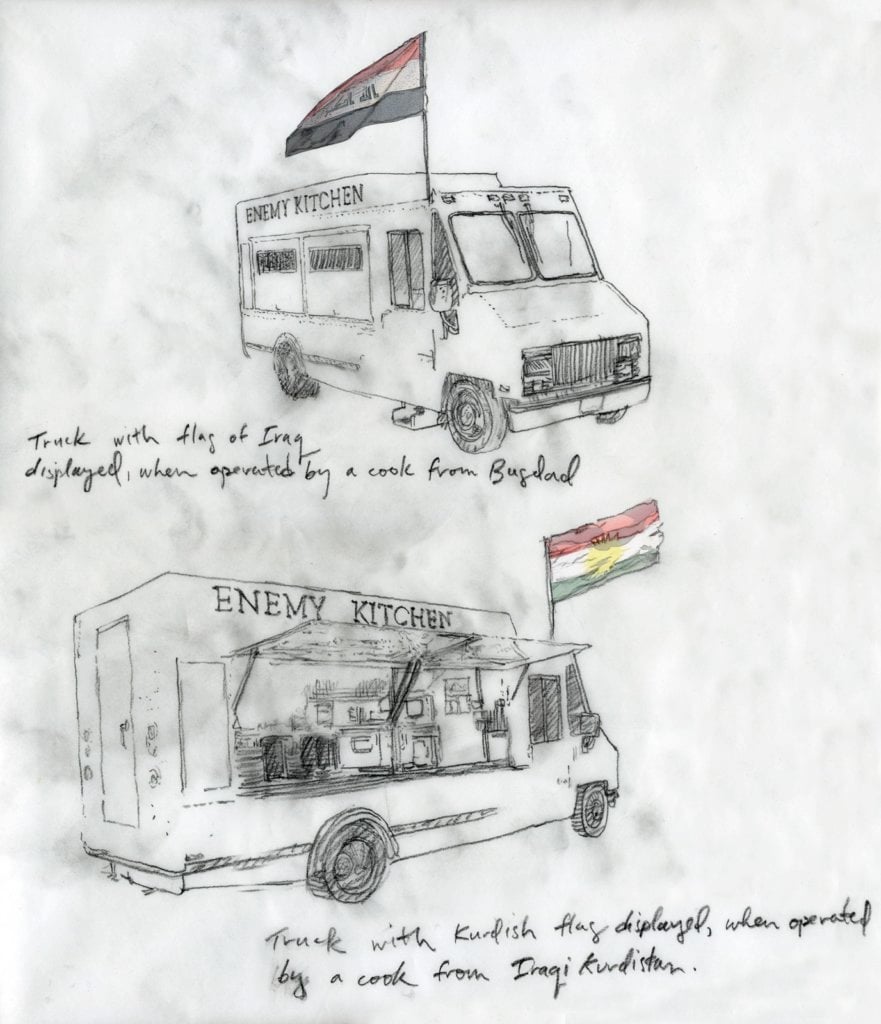
Michael Rakowitz, Sketch for Enemy Kitchen (2012–ongoing). Courtesy of the artist and Rhona Hoffman Gallery, Chicago; Jane Lombard Gallery, New York; Galerie Barbara Wien, Berlin.
When you moved to Chicago in 2006, the project went with you. How did Enemy Kitchen change form with that move?
As opposed to New York, there is a large Iraqi community in Chicago. But most of the Iraqi restaurant owners advertise themselves as Mediterranean, because they don’t feel safe in a war culture. There’s not a Mediterranean coast even close to Iraq! On the truck, the Iraqis from Milo’s Pita Place, a Chicago restaurant, are the chefs, while the vets are the sous chefs and servers. That reverses the typical hierarchy that exists between American GIs and the Iraqi military in Iraq.
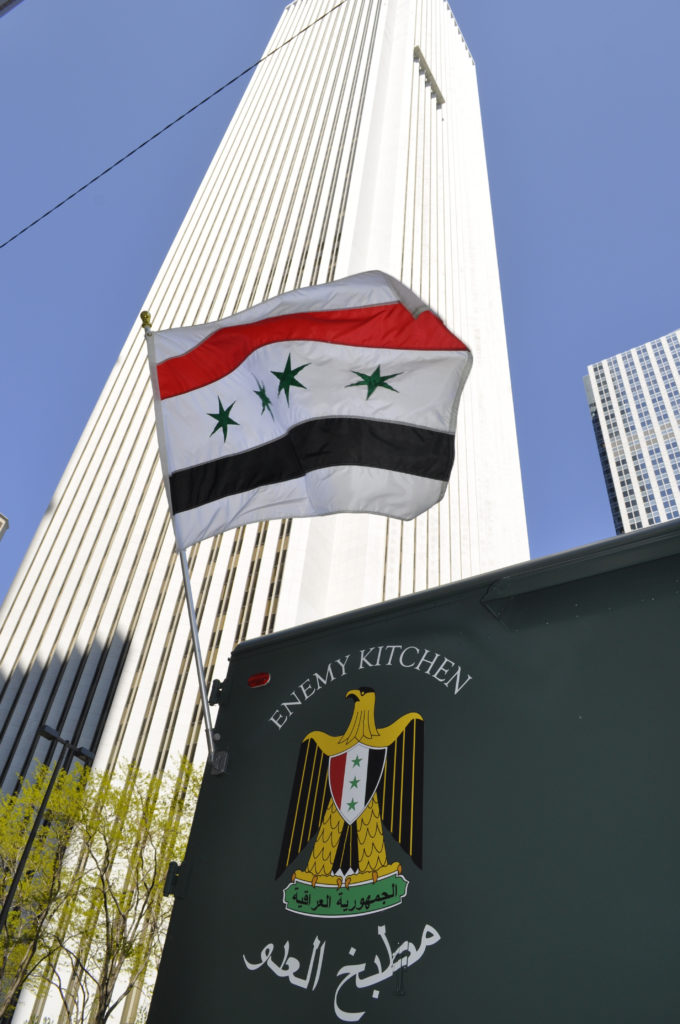
Michael Rakowitz’s Enemy Kitchen (2012–ongoing). Courtesy of the artist and Rhona Hoffman Gallery, Chicago; Jane Lombard Gallery, New York; Galerie Barbara Wien, Berlin.
The logo on the truck is the Iraqi coat of arms, which is basically the same as the US’s, and it flies the Chicago flag rendered in Iraqi colors. The paper plates we use are modeled on plates looted from Saddam’s palaces, and the knives were fashioned by Sayyed Haidar Ahmed Muhsin, Saddam’s personal sword maker. So it’s about mobilizing materials that were militarized with the goal of restoring some humanity.
As far as working with the “enemy,” how do you arrive at a collaboration where the Iraqis’ voices are heard in a way that’s meaningful to them?
At first they said, “If you really want to sell food, you have to call it ‘Friendly Kitchen,'” but that’s not an artwork I would want to make. So I explained that it’s meant to be a little strange. When they understood the provocation, they were totally on board. And in fact, the truck has created a steady flow of traffic to the restaurant, such that they were able to move to a larger place and even to open a nightclub, Milo’s Palace. So it went from pitas to a palace, and Milo’s Palace is now called the Babylon Bistro. When they started to refer to themselves in that way, the project came full circle.
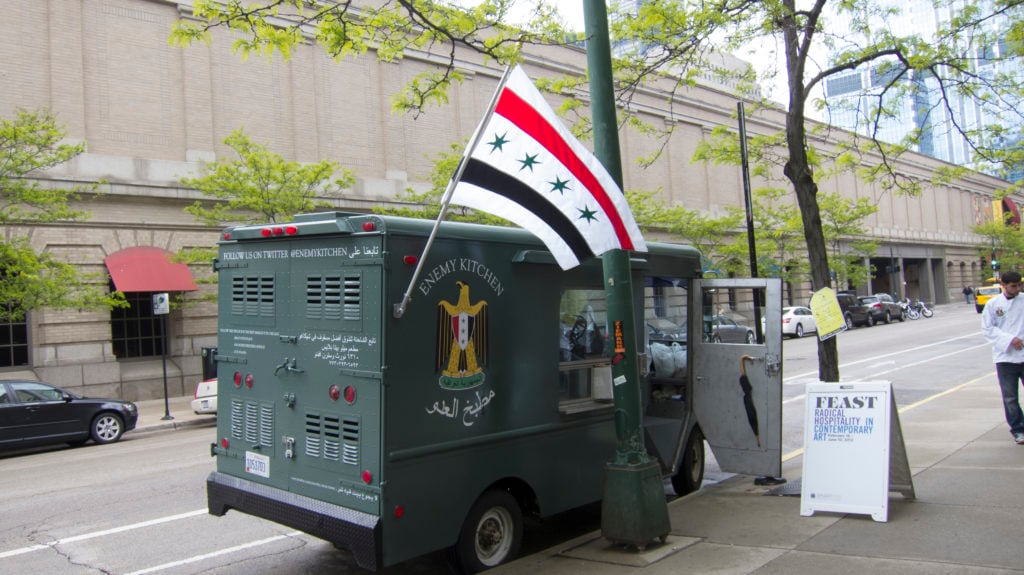
Michael Rakowitz’s Enemy Kitchen (2012–ongoing). Photo by Greg Broseus, courtesy of the artist and Rhona Hoffman Gallery, Chicago; Jane Lombard Gallery, New York; Galerie Barbara Wien, Berlin.
It’s remarkable that the piece has lasted so long and taken on so many forms.
The work has to be able to surprise me or I’m not interested. It’s like cooking. It changes over time. The good thing about Iraqi food is, the longer you let it sit, the better it tastes.
“Origin Story” is a column in which we examine the backstory of an individual work of art.
“Michael Rakowitz: Backstroke of the West” is on view at the Museum of Contemporary Art Chicago through March 4, 2018.